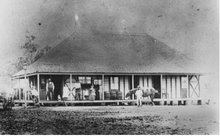Mitsubishi has just brought its new electric car to Australia to start the required pre-marketing testing. Newspapers have been touting the i MiEV as the way of the future: an electric car that can be charged up overnight from a regular power point and can carry four people.
All other things aside, such as the fact that most electricity in Australia is generated in coal-burning power plants so that electricity is not quite the clean power source that it is marketed as, this is a car that goes 160 kilometres on one charge. After a week in which I seemed to spend a significant chunk of my time glued into the driver’s seat of my car, a 160 kilometre range seems laughable. For instance yesterday, between doctor, dentist, work for Mr. Blithe, the school run, the butcher and Blithe Girl’s after-school Italian lesson, between us, Mr Blithe and I drove over 200 kilometres. We’re only peri-urbanites, not even real country. A round trip into Brisbane is 100 kilometres. A weekend visit to my mother-in-law is 190 kilometres each way. One couldn’t do the trip in an i MiEV (at least not without pausing for an overnight stay on the way). When my mother was a child, the four-hour drive from Sydney to Canberra was a two day trip with an overnight camp on the way. It’s amusing that this great step for modernity would almost be a reversion to the past.
And we couldn’t fit the whole family into the car. This is an urban runabout aimed squarely at the average Australian, and probably the developed world family unit: one or two adults who mainly catch public transport to work and need something for shopping or daytrips. They might have a child or maybe two who need to be transported to daycare or school. I’m guessing child seats in the back would be a squeeze.
We are people who care about the environment, who drive fuel-efficient, boring four-cylinder petrol vehicles in as boring a manner as possible aiming for fuel efficicency rather than performance. We carefully plan most driving so that we can do as many things in one trip as we can. But like most country residents we are dependent on our vehicles for work, sustenance and everyday life. We have two cars because we have to. We also own land on which we regularly plant trees. One environmental group has suggested that people need to plant two trees per car per year and we are ahead of the curve on that.
What has this to do with local history or writing or this blog? Well, often I spend time thinking about how where we live affects every aspect of our everyday lives. I read articles proclaiming the end of the motor vehicle and I think about the impact of that on rural communities. I envisage a future where rural residents will either be forced to move into cities, compounding Australia’s urban population crunch or we will be anachronisms, the only people left in Australia driving vehicles powered by petroleum by-products. Perhaps we will even be sneered at as environmental vandals or protected as a vulnerable species.
Sometimes it is as interesting to speculate on the future as it is on the past.
Friday, 27 March 2009
Subscribe to:
Post Comments (Atom)

No comments:
Post a Comment